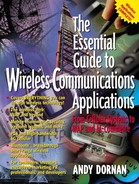Private Mobile Radio
PMR systems were once separate from the public network, used only to communicate between closed groups of people. They existed before mobile phones became widespread and were used by people for whom radio communication is absolutely critical. The main users included emergency services, public utilities, and taxi companies.
With the arrival of mobile phones, private mobile radio has become less private. While groups such as the police still operate their own networks, third-party providers have begun to offer services that interconnect to the public network and compete directly with cellular. Marketed at all kinds of businesses and even consumers, these publicly available PMR systems are sometimes known as PAM (Private Access Mobile Radio) or SMR (Specialized Mobile Radio).
There are two main types of digital PMR, both of which are used in public and private systems worldwide. Called TETRA and iDEN, they have many similarities with each other and with GSM, on which they are loosely based. Both use TDMA technology and paired spectrum, and have all the usual cellphone features, such as voice and short data messages. They add the ability to provide extra services, most importantly,
Group calling, which sets up conference calls to predefined groups at the press of a button
Phone-to-phone mode, where two phones communicate without a base station
Instant call setup for voice and data, similar to ISDN on the fixed network
Prioritization, so that certain calls are dropped in favor of others if the network becomes overcrowded
PMR systems also tend to have greater spectral efficiency, though at the cost of reduced quality. This is because call quality is generally considered less important to groups such as the military than to most business and personal customers. Table 4.13 shows how TETRA and iDEN differ.
| System | TETRA | iDEN |
|---|---|---|
| Designer | ETSI | Motorola |
| Channel bandwidth | 25 kHz | 25 kHz |
| TDMA slot length | 14.17 ms | 15.0 ms |
| Calls (TDMA slots) per channel | 4 | 6 |
| Maximum data rate per channel | 36 kbps | 64 kbps |
| Modulation | D-QPSK | QAM |
TETRA
Originally Trans-European Trunked Radio, TETRA was designed by ETSI in close cooperation with Europe's police forces. As with its other standards, ETSI hoped that TETRA would eventually be deployed beyond Europe, and so renamed it to Terrestrial Trunked Radio.
Aside from the PMR services described above, TETRA's main feature is its extreme security. While most protocols provide some way for the cellular network to authenticate the mobile phone, TETRA also requires that the network prove its identity to the phone. This was designed so that criminals would not be able to fool the police by setting up a fake network, though critics of the system say it verges on the paranoid.
Paranoia may be justified. While other mobile systems allow operators to track a user's location, only TETRA also offers a feature called ambient listening. This literally turns the phone into a bug—the operator can listen into and record anything that the user is saying, even when the phone is apparently switched off. It was designed by police for hostage situations and as an anti-theft measure, but understandably is not widely advertised by commercial operators.
For users not interested in security or other PMR services, TETRA does have one more advantage: it uses very low frequencies, around 400 MHz, enabling large cells of up to about 100 km in radius. This means that a network can be rolled out very quickly. The largest public operator, Dolphin Telecommunications, managed to build a network across six European countries (Britain, France, Belgium, Germany, Spain, and Portugal) in little more than a year.
iDEN
The integrated Digital Enhanced Network is a proprietary system, but a popular one in the U.S. It was developed by Motorola and is operated by several companies, the largest being Nextel. Because of the FCC's technology-neutral licensing policy, it occupies the same PCS 1900 MHz spectrum that other operators choose to give to GSM or cdmaOne.
normal: Web ResourcesThe GSM Association site also covers GPRS and HSCSD. http://www.gsmdata.com and http://www.pcsdata.com Designed to aid anyone who wants to send data over digital cellular networks, these two sites contain many articles on existing and future wireless systems. The sites run by Intel, which has an obvious interest in promoting data apps, but is not tied to any particular phone technology or vendor. http://www.ece.wpi.edu/courses/ee535/hwk11cd95/tara/tara.html This site from Worcester Polytechnic Institute in Massachusetts, contains a detailed description of D-AMPS. It's part of a wider online resource aimed at engineering students, covering all kinds of mostly non-wireless telecom topics. The CDMA Development Group promotes all types of CDMA technology, including cdmaOne and future third-generation systems. It also provides detailed technical and mathematical information about spread spectrum technology. http://www.electricrates.com/trforum/ This is a Web forum set up to discuss all forms of Private Mobile Radio, including TETRA, iDEN, and APOC25. http://www.tetramou.org and http://www.tetraforum.org These sites are offered by the TETRA Memorandum of Understanding, which oversees the TETRA standard, and its U.S. subsidiary, the NATF (North American TETRA Forum). |
